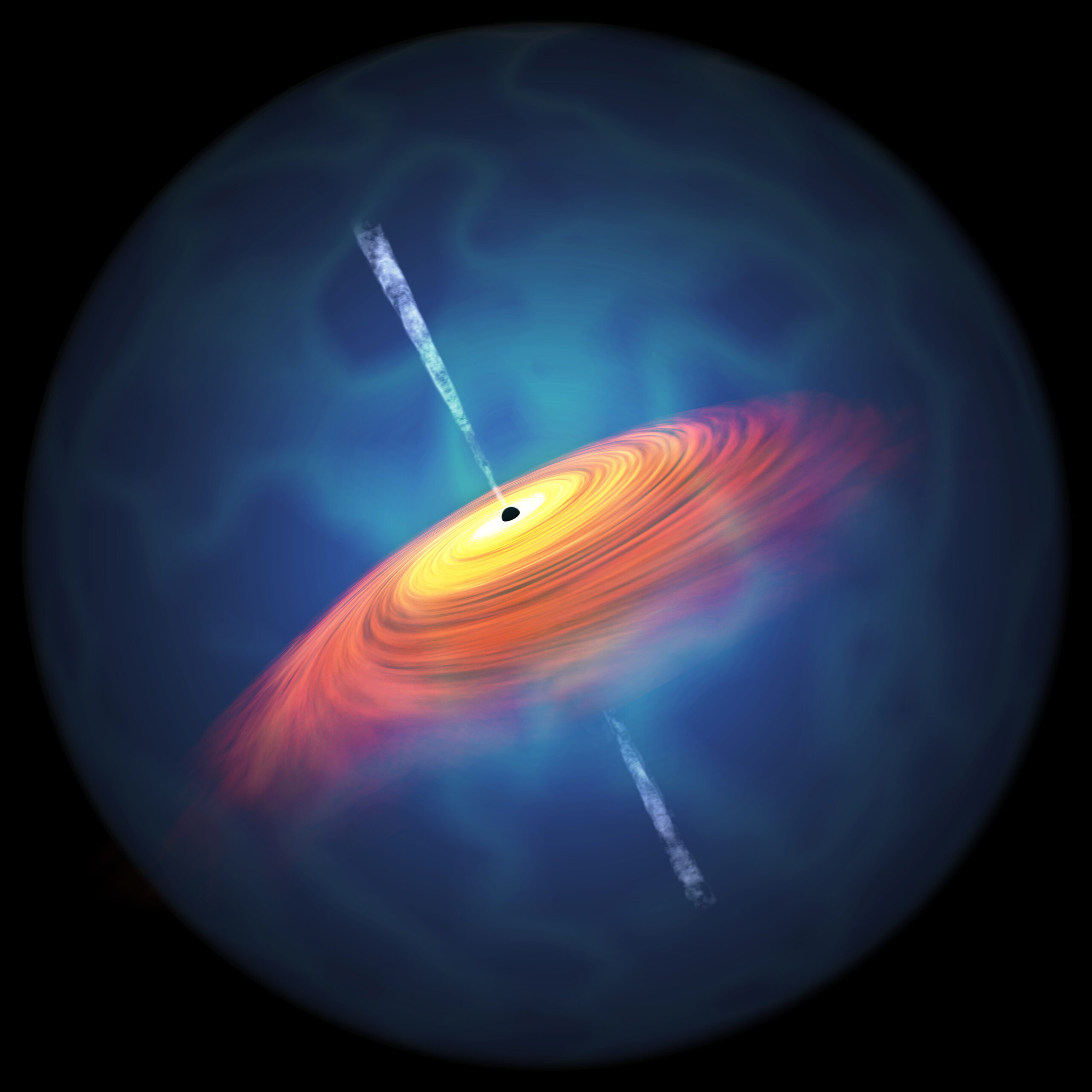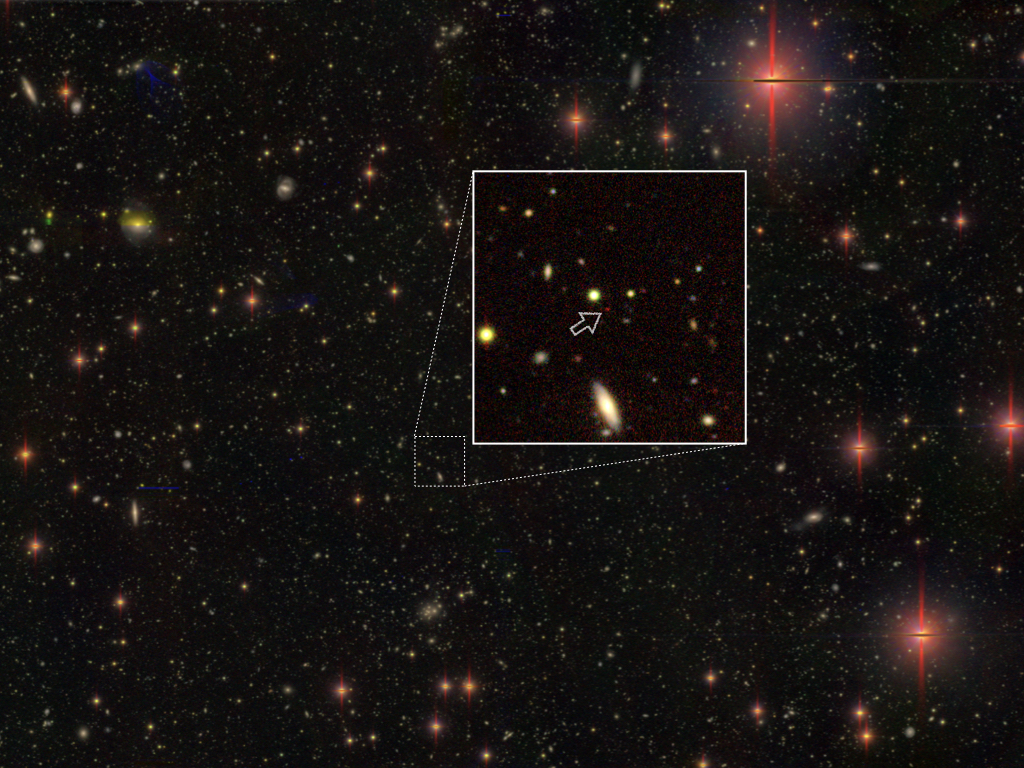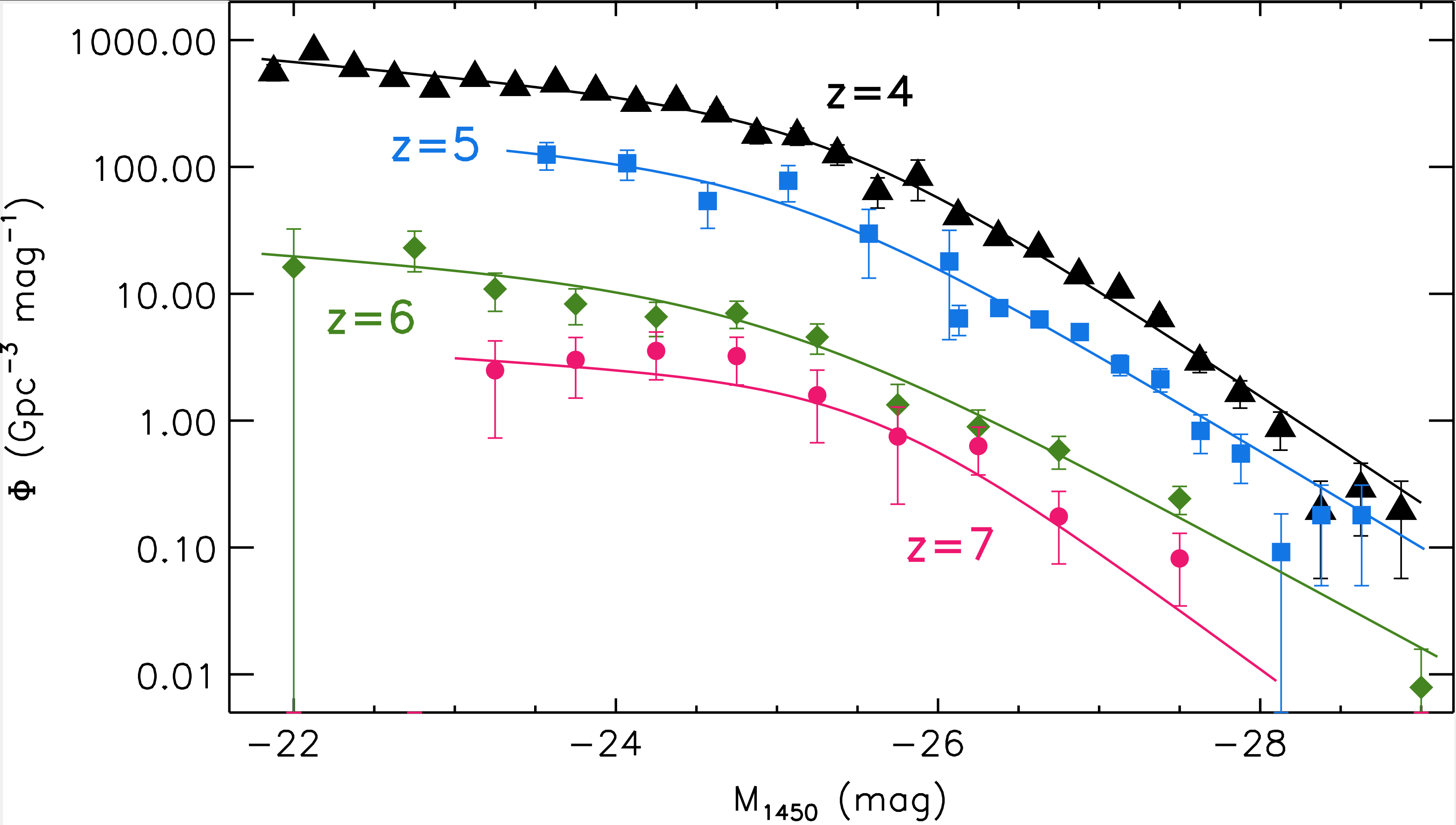Hunting for Supermassive Black Holes in the Early Universe
Survey observations with the Subaru Telescope have led to the discovery of 22 quasars in the very distant universe. Their space density indicates the rapid emergence of supermassive black holes soon after the Big Bang, providing strong constraints on models of when, where, and how they formed and grew in cosmic space-time. The results also indicate a small quasar contribution to cosmic reionization, a major phase transition of the early universe.
Supermassive black holes (SMBHs) – black holes with masses exceeding a million times that of the Sun – are known to prevail in the universe today. However, it is not clear yet when, where, and how they formed during the 13.8 billion years of cosmic history. Observations in the past few decades have revealed that every galaxy harbors a SMBH in the center, and that the black hole mass is almost always one-thousandth of the host galaxy mass. This close relationship implies that galaxies and SMBHs have co-evolved together. Revealing the origin of SMBHs is thus crucial not only to understand SMBHs themselves, but also to elucidate the formation processes of galaxies, the major constituents of the visible universe.
A key to addressing this issue lies in the early universe, where the time elapse since the Big Bang (i.e., the beginning of the universe) was less than a billion years. Thanks to the finite speed of light, we can look back at the past by observing the distant universe. Did SMBHs already exist when the universe was only a billion years old or less? Is it possible for a black hole to acquire such a large mass (exceeding a million solar masses and sometimes reaching billions of solar masses) in such a short time? If so, what are the underlying physical mechanisms and conditions? In order to close in on the origin of SMBHs, we need to observe them and compare their properties with predictions from theoretical models. And in order to do so, we first need to find where they are in the sky.
We used the Subaru Telescope at the top of Maunakea, Hawaii, for the present study. One of the biggest advantages of Subaru is its widefield observing capability, which is particularly suited for our purpose. Since SMBHs do not emit light, we looked for a special class called “quasars” – SMBHs with shining outskirts where the infalling material releases gravitational energy. We observed a wide sky area equivalent to 5000 times the full moon, and successfully discovered 162 quasars residing in the early universe. In particular, 22 of them lived in the era when the universe was less than 800 million years old – the most ancient period in which quasars have been recognized to date. The large number of quasars we discovered has allowed us to determine the most fundamental measure called the “luminosity function”, which describes the space density of quasars as a function of radiation energy. We found that quasars were forming very rapidly in the early universe, while the overall shape of the luminosity function (except for the amplitude) remained unchanged over time. This characteristic behavior of the luminosity function provides strong constraints on theoretical models, which could ultimately reproduce all the observables and describe the origin of SMBHs.
On the other hand, the universe was known to have experienced a major phase transition called “cosmic reionization” in its early stage. Past observations suggest that the whole intergalactic space was ionized in this event. The source of the ionization energy is still under debate, with radiation from quasars being considered as a promising candidate. By integrating the above luminosity function, we found that quasars emit 1028 photons per second in a unit volume of 1 light-year on a side in the early universe. This is less than 1% of the photons needed to maintain the ionized state of the intergalactic space at that time, and thus indicates that quasars made only a minor contribution to cosmic reionization. Other energy sources are critically needed, which, according to other recent observations, may be the integrated radiation from massive hot stars in forming galaxies.
Reference URL: https://iopscience.iop.org/article/10.3847/2041-8213/acd69f
Bibliographic Information
Quasar Luminosity Function at z = 7, Yoshiki Matsuoka, Masafusa Onoue, Kazushi Iwasawa, and
41 co-authors, The Astrophysical Journal Letters, 949, L42, doi: 10.3847/2041-8213/acd69f, 2023 (June 1)
Fundings
- Japan Society for the Promotion of Science (JSPS) KAKENHI Grant Number 17H04830, 21H04494
- Mitsubishi Foundation Grant No. 30140
- National Natural Science Foundation of China (12073003, 11991052, 11721303, 12150410307, 11950410493)
- China Manned Space Project Nos. CMS-CSST-2021-A04 and CMS-CSST-2021-A06
- Grant PID2019-105510GB-C33 funded by MCIN/AEI/10.13039/ 501100011033 of Spain
- “Unit of excellence María de Maeztu 2020–2023” awarded to ICCUB (CEX2019-000918-M) of Spain
Media
-

An artist’s impression of a quasar
A supermassive black hole (SMBH; the small black dot at the center) absorbs surrounding material, which forms a spiral disk-like shape as it flows in. The gravitational energy of the material is converted to radiation and emitted away from the disk. SMBHs with such shining outskirts are called “quasars”.
credit : Yoshiki Matsuoka
Usage Restriction : Please get copyright permission -

Light from a distant quasar captured by the Subaru Telescope
An example of the night-sky photograph we took with the Subaru Telescope. The tiny red dot at the center of the magnified image represents the light from a distant quasar, which existed when the universe was 800 million years old (13 billion light-years away).
credit : National Astronomical Observatory of Japan
Usage Restriction : Please get copyright permission -

Luminosity function of quasars in the early universe
Luminosity function describes the space density (Φ on the vertical axis) as a function of radiation energy (M1450 on the horizontal axis). We plot the luminosity functions of quasars observed when the age of the universe was 0.8 (red dots), 0.9 (green diamonds), 1.2 (blue squares), and 1.5 (black triangles) billion years. The curves represent the best-fit functional forms. The space density of quasars rose steeply over time, while the shape of the luminosity function remains almost unchanged.
credit : The Astrophysical Journal Letters, 949, L42, 2023
Usage Restriction : Follow the relevant instruction of The Astrophysical Journal Letters
Contact Person
Name : Yoshiki Matsuoka
Phone : +81-89-927-9579
E-mail : yk.matsuoka@cosmos.ehime-u.ac.jp
Affiliation : Research Center for Space and Cosmic Evolution, Ehime University
